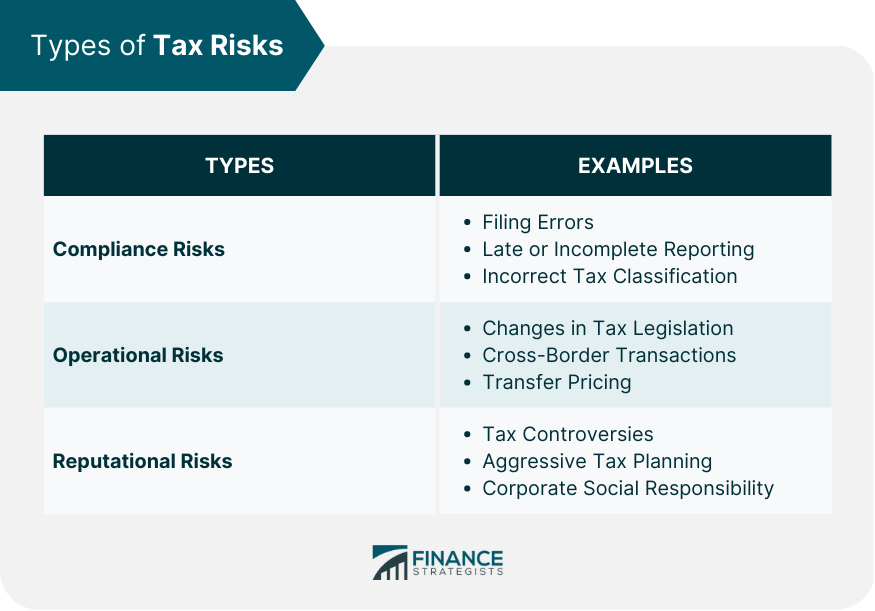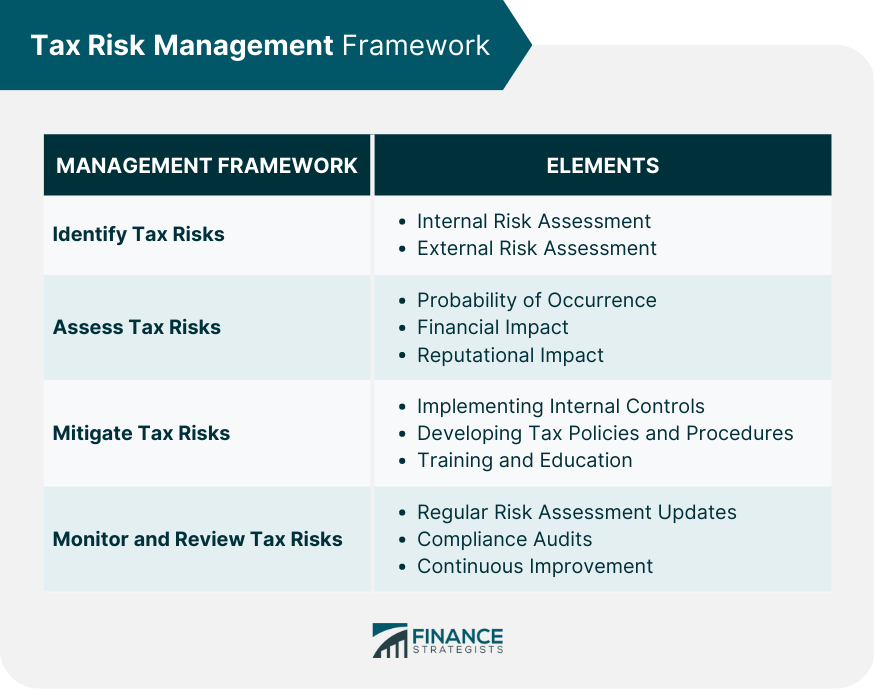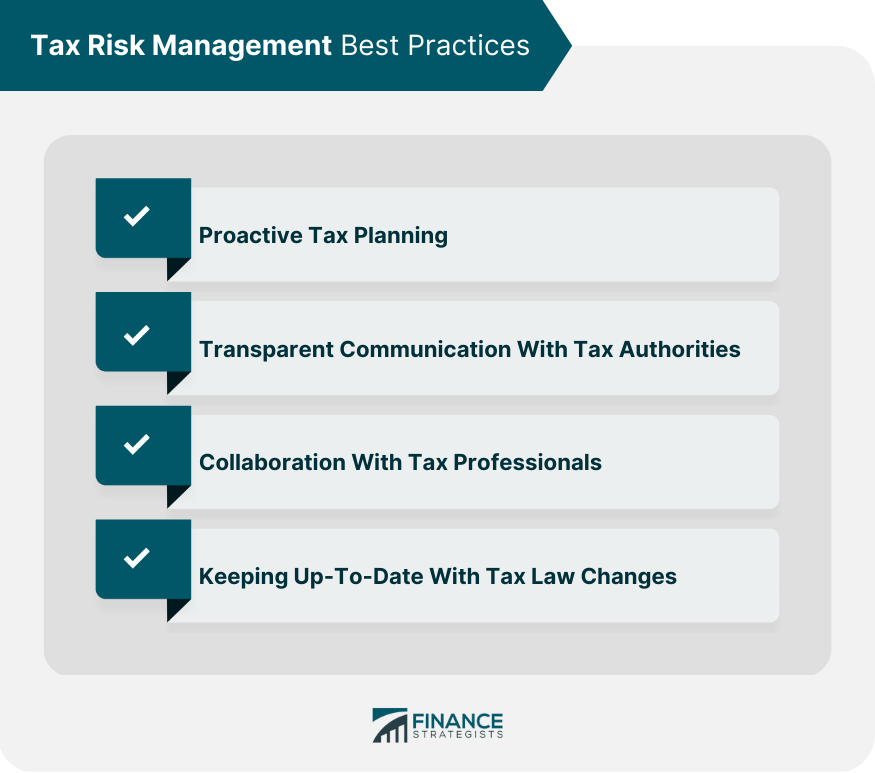Tax risk management involves identifying, assessing, and mitigating tax-related risks that may impact businesses and individuals. This process aims to minimize the potential negative consequences of tax risks, such as financial penalties, legal issues, and reputational damage. Tax risk management is crucial for businesses and individuals as it helps ensure compliance with tax laws and regulations, reducing the likelihood of financial penalties and legal issues. Moreover, effective tax risk management can enhance a business's reputation and contribute to long-term financial stability. An effective tax risk management strategy comprises several key components, including identifying and assessing tax risks, implementing appropriate risk mitigation measures, and monitoring and reviewing tax risks regularly. This comprehensive approach helps businesses and individuals avoid potential tax issues and comply with ever-changing tax laws and regulations. Filing errors refer to mistakes made while preparing and submitting tax returns, such as incorrect data entry or calculation errors. These errors can lead to inaccurate tax reporting, resulting in potential financial penalties and increased scrutiny from tax authorities. Late or incomplete reporting involves the failure to submit tax returns or required documentation within specified deadlines. This can result in fines, penalties, and interest charges, negatively impacting a business's or individual's financial situation. Incorrect tax classification occurs when businesses or individuals improperly classify their income, expenses, or transactions for tax purposes. This can lead to underpayment or overpayment of taxes and may result in financial penalties or legal issues. Changes in tax legislation refer to alterations in tax laws and regulations that may impact businesses and individuals. Staying current with these changes is essential for maintaining compliance and avoiding potential financial and legal consequences. Cross-border transactions involve international trade, investments, or operations that may be subject to varying tax rules and regulations. These transactions can create tax risks due to differing tax requirements and potential double taxation issues. Transfer pricing refers to the pricing of transactions between related entities within a multinational corporation. Tax authorities scrutinize these transactions closely to ensure they are conducted at arm's length and in compliance with transfer pricing regulations, which can pose tax risks if not managed properly. Tax controversies arise when tax authorities dispute a business's or individual's tax positions or practices. These controversies can lead to audits, investigations, or litigation, potentially damaging a company's or individual's reputation and financial standing. Aggressive tax planning involves implementing tax strategies that push the boundaries of tax laws and regulations to minimize tax liabilities. Such practices can attract the attention of tax authorities and may result in negative consequences, including financial penalties and reputational damage. Corporate social responsibility (CSR) encompasses a company's commitment to ethical behavior, social welfare, and environmental sustainability. Tax practices that are perceived as unethical or overly aggressive can harm a company's CSR efforts and damage its reputation. Internal risk assessment involves evaluating a business's or individual's internal processes, policies, and practices to identify potential tax risks. This assessment helps pinpoint areas where improvements or changes may be necessary to ensure compliance with tax laws and regulations. External risk assessment involves examining external factors, such as changes in tax laws or regulations, that may impact a business's or individual's tax obligations. Assessing the probability of occurrence involves estimating the likelihood that a specific tax risk will materialize. Understanding the likelihood of potential tax risks can help businesses and individuals prioritize their risk management efforts and allocate resources effectively. Evaluating the financial impact of tax risks involves estimating the potential monetary consequences of tax errors or non-compliance, such as fines, penalties, and interest charges. This assessment helps businesses and individuals understand the potential severity of tax risks and prioritize their mitigation efforts. Assessing the reputational impact involves considering the potential damage to a business's or individual's reputation due to tax controversies, aggressive tax planning, or non-compliance with tax laws. By understanding the reputational risks associated with tax issues, businesses and individuals can take appropriate steps to protect their public image. Implementing internal controls involves establishing procedures and processes to monitor and manage tax risks effectively. These controls help ensure compliance with tax laws and regulations, reducing the likelihood of errors, late reporting, or other tax-related issues. Developing tax policies and procedures involves creating a comprehensive set of guidelines and instructions for managing tax-related activities within a business or for an individual. These policies and procedures help ensure consistent tax practices and reduce the likelihood of tax errors or non-compliance. Providing training and education on tax laws, regulations, and best practices is crucial for ensuring that employees and individuals understand their tax obligations and responsibilities. Ongoing training can help prevent tax errors, improve compliance, and reduce tax risks. Regular risk assessment updates involve reviewing and updating tax risk assessments to ensure they remain current and accurate. These updates help businesses and individuals stay informed about changes in tax laws and regulations and address emerging tax risks proactively. Compliance audits involve reviewing a business's or individual's tax practices, records, and reporting to ensure compliance with tax laws and regulations. These audits can help identify potential issues, allowing for timely corrections and improvements. Continuous improvement in tax risk management involves regularly evaluating and refining tax policies, procedures, and internal controls to enhance their effectiveness. This ongoing process helps businesses and individuals maintain compliance with tax laws and regulations and minimize their exposure to tax risks. Tax advisors and consultants provide expert guidance on tax laws, regulations, and planning strategies. They assist businesses and individuals in navigating complex tax issues, minimizing tax liabilities, and ensuring compliance with tax laws and regulations. In-house tax departments manage a company's tax obligations and risks. They develop and implement tax policies, procedures, and internal controls, ensuring the company complies with tax laws and regulations while minimizing tax liabilities. External auditors independently assess a company's financial statements, tax filings, and internal controls to ensure accuracy and compliance with tax laws and regulations. Their objective evaluation helps identify potential tax risks and areas for improvement in a company's tax practices. Proactive tax planning involves anticipating potential tax risks and developing strategies to minimize them before they materialize. This approach helps businesses and individuals maintain compliance, reduce tax liabilities, and avoid costly tax controversies. Transparent communication with tax authorities involves openly discussing tax positions, transactions, and interpretations of tax laws. This practice can help prevent misunderstandings, facilitate cooperation, and reduce the likelihood of disputes or investigations. Collaborating with tax professionals, such as tax advisors, consultants, and external auditors, can help businesses and individuals manage tax risks more effectively. These professionals provide valuable expertise, guidance, and support in navigating complex tax issues and ensuring compliance. Staying informed about changes in tax laws and regulations is essential for effective tax risk management. Businesses and individuals must continuously update their tax practices, policies, and procedures to ensure compliance with evolving tax requirements. Effective tax risk management is essential for businesses and individuals to maintain compliance with tax laws and regulations, minimize tax liabilities, and protect their reputations. Implementing a comprehensive tax risk management strategy can provide numerous benefits, such as improved compliance, reduced tax liabilities, enhanced reputation, and long-term financial stability. A well-executed strategy helps businesses and individuals proactively address tax risks and achieve their financial goals. Tax risk management is an ongoing process that requires continuous monitoring, evaluation, and improvement. Businesses and individuals must stay current with tax laws and regulations, adapt their tax practices accordingly, and work with tax professionals to ensure continued compliance and effective risk mitigation. Contact a trusted tax advisor or consultant today to develop a comprehensive and proactive tax risk management strategy tailored to your needs.What Is Tax Risk Management?
Types of Tax Risks

Compliance Risks
Filing Errors
Late or Incomplete Reporting
Incorrect Tax Classification
Operational Risks
Changes in Tax Legislation
Cross-Border Transactions
Transfer Pricing
Reputational Risks
Tax Controversies
Aggressive Tax Planning
Corporate Social Responsibility
Tax Risk Management Framework
Identifying Tax Risks
Internal Risk Assessment
External Risk Assessment
Assessing Tax Risks
Probability of Occurrence
Financial Impact
Reputational Impact
Mitigating Tax Risks
Implementing Internal Controls
Developing Tax Policies and Procedures
Training and Education
Monitoring and Reviewing Tax Risks
Regular Risk Assessment Updates
Compliance Audits
Continuous Improvement

Role of Tax Professionals in Tax Risk Management
Tax Advisors and Consultants
In-House Tax Departments
External Auditors
Tax Risk Management Best Practices

Proactive Tax Planning
Transparent Communication With Tax Authorities
Collaboration With Tax Professionals
Keeping Up-To-Date With Tax Law Changes
Final Thoughts
Tax Risk Management FAQs
Tax risk management is the process of identifying, assessing, mitigating, and monitoring tax-related risks to ensure compliance with tax laws and regulations. It is crucial for businesses and individuals to minimize tax liabilities, avoid financial penalties, and protect their reputation.
Tax professionals, such as tax advisors, consultants, and external auditors, provide expert guidance and support in navigating complex tax issues, ensuring compliance, and developing effective tax risk management strategies to minimize tax liabilities and risks.
Best practices for effective tax risk management include proactive tax planning, transparent communication with tax authorities, collaboration with tax professionals, and staying up-to-date with tax law changes.
Identifying and assessing tax risks involve conducting internal and external risk assessments, evaluating the probability of occurrence, financial impact, and reputational impact of potential tax risks. Regular risk assessment updates and compliance audits can help maintain accurate and current risk evaluations.
A tax risk management framework provides a structured approach to identifying, assessing, mitigating, and monitoring tax risks. It involves implementing internal controls, developing tax policies and procedures, providing training and education, and continuously monitoring and reviewing tax risks for effective risk management.
True Tamplin is a published author, public speaker, CEO of UpDigital, and founder of Finance Strategists.
True is a Certified Educator in Personal Finance (CEPF®), author of The Handy Financial Ratios Guide, a member of the Society for Advancing Business Editing and Writing, contributes to his financial education site, Finance Strategists, and has spoken to various financial communities such as the CFA Institute, as well as university students like his Alma mater, Biola University, where he received a bachelor of science in business and data analytics.
To learn more about True, visit his personal website or view his author profiles on Amazon, Nasdaq and Forbes.













